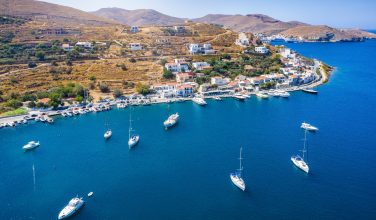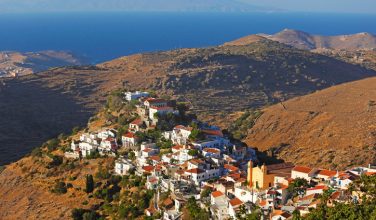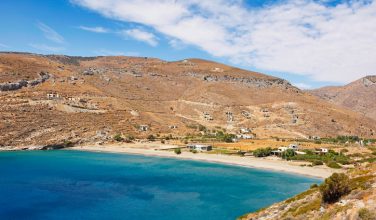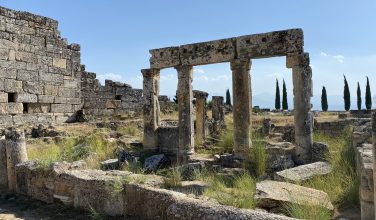Kea is an island in the Cyclades group in the Aegean Sea. Kea is a hilly island, but not very mountainous. The highest peak is Prophet Elias at 561 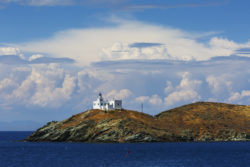 meters. The landscape of the island of Kea has slopes with olive trees. Almond trees and oak trees also dot the land. Along the coastline there are small coves and beaches. The capital of the island of Kea is Ioulida and the main port is Korissia.
meters. The landscape of the island of Kea has slopes with olive trees. Almond trees and oak trees also dot the land. Along the coastline there are small coves and beaches. The capital of the island of Kea is Ioulida and the main port is Korissia.
The island of Kea is the location of a Bronze Age settlement that is now a site called Ayia Irini. The settlement reached its height during the Late Minoan and Early Mycenaean eras from 1600 – 1400 BC. During the Archaic period, Kea was divided into four city-states: Ioulis, Karthaia, Poiessa, and Koressos. During the Classical period, the island of Kea was home to Simonides and his nephew Bacchylides, both Greek lyric poets.
Inhabitants of the island were known to offer sacrifices to Dog Star, Sirius, and Zeus in hopes of bringing cool breezes while waiting for the reappearance of Siruis during the summer. If the star rose clear, this meant good luck. If it was faint, this foretold pestilence. Coins found on the island dating to the 3rd century BC feature dogs or stars with emanating rays.
During the Byzantine period, a lot of churches were built on the island of Kea. The prosperity of the island would, in turn, rise. In the wake of the Fourth Crusade, the island was captured by the Venetians. Michael Choniates, the Archbishop of Athens, would go to Kea in exile when his city fell to the Crusaders in 1205. The Byanztines would gain control of the island under Licario in 1278. Then around 1302, during the Byzantine-Venetian War, the island would fall once again to the Venetians. The Venetians built a castle on the ancient acropolis of Ioulis. Finally in 1821, the island of Kea would join Greece.
Administrative Region of Kea Island, Greece
South Aegean
Area of Kea Island, Greece
148.9 km2 (57.5 sq mi)
Population of Kea Island, Greece
2,455
Top Attractions in Kea Island, Greece
Archaeological Museum – Located in Ioulida, close to the Castle of Ioulida. The museum showcases findings from excavations around the island. The collections are divided into two sections: pre-historical and historic.
Monastery of Agia Anna – Located on a hill above Ioulida. This monastery played a large role in the development of the island. It was built during the 16th century.
Prehistoric Settlement of Agia Irini – This settlement dates back to approximately 3,300 BC. Excavations in this area have uncovered art objects, clay ovens, and long jars. The settlement was characterized by rocky elevations overlooking the sea.
Church of Agia Marina – Located in Ioulida. This church stands next to a ruined Byzantine tower. The church used to be part of a monastery that was built in the 17th century.
Stone Lion – Dating back to prehistoric times, this stone lion head is built on a rock. It’s located along a short hiking path from Ioulida. The stone lion is connected to different legends and traditions of the island of Kea.
Koundouros Beach – 15 km southwest of Ioulida. This is one of the most popular beaches on the island as it well-organized with tourist facilities nearby. There are water sports as well as a diving club on site.
Korissia Beach – 6 km northwest of Ioulida. Korissa Beach is located within walking distance of the port, hotels, and beach bars. The beach is family friendly, partly organized with sun beds and umbrellas, and home to a diving club.
Otzias Beach – 10 km north of Ioulida on the northernmost part of the island. Otzias Beach is partly organized with some tourist facilities around. This is a family friendly beach that is sandy with clean water.


